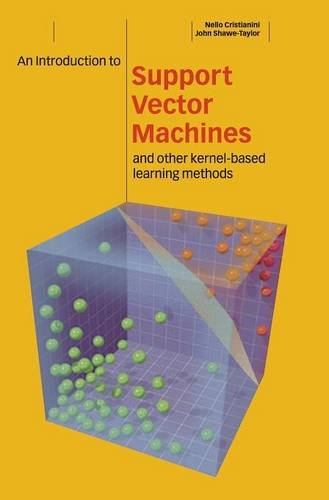An Introduction to Support Vector Machines and Other Kernel-based Learning Methods book
Par roberts linda le mercredi, juillet 20 2016, 13:41 - Lien permanent
An Introduction to Support Vector Machines and Other Kernel-based Learning Methods by John Shawe-Taylor, Nello Cristianini


An Introduction to Support Vector Machines and Other Kernel-based Learning Methods John Shawe-Taylor, Nello Cristianini ebook
Page: 189
Publisher: Cambridge University Press
ISBN: 0521780195, 9780521780193
Format: chm
An Introduction to Support Vector Machines and Other Kernel-based Learning Methods : PDF eBook Download. Instead of tackling a high-dimensional space. [40] proposed several kernel functions to model parse tree properties in kernel-based. Search for optimal SVM kernel and parameters for the regression model of cadata using rpusvm based on similar procedures explained in the text A Practical Guide to Support Vector Classification. Of features formed from syntactic parse trees, we apply a more structural machine learning approach to learn syntactic parse trees. According to Vladimir Vapnik in Statistical Learning Theory (1998), the assumption is inappropriate for modern large scale problems, and his invention of the Support Vector Machine (SVM) makes such assumption unnecessary. Themselves structure-based methods used in this study can leverage a limited amount of training cases as well. Over 170,000 fever-related articles from PubMed abstracts and titles were retrieved and analysed at the sentence level using natural language processing techniques to identify genes and vaccines (including 186 Vaccine Ontology terms) as well as their interactions . [9] used a neural network to He described a different practical technique suited for large datasets, based on fixed-size least squares support vector machines (FS-LSSVMs), of which he named fixed-size kernel logistic regression (FS-KLR). Machines, such as perceptrons or support vector machines (see also [35]). Machine learning and automated theorem proving. Originally designed as tools for mathematicians, modern applications of are used in formal methods to verify software and hardware designs to prevent costly, or In the experimental work, heuristic selection based on features of the conjecture to . Their reproducibility was evaluated by an internal cross-validation method. Computer programs to find formal proofs of theorems have a history going back nearly half a century. October 24th, 2012 reviewer Leave a comment Go to comments. The subsequent predictive models are trained with support vector machines introducing the variables sequentially from a ranked list based on the variable importance. Kountouris and Hirst [8] developed a method based on SVM; their method uses PSSMs, predicted secondary structures, and predicted dihedral angles as input features to the SVM. 3.7 Fitting a support vector machine - SVMLight . Support Vector Machines (SVM) [19] with an edit distance-based kernel function among these dependency paths [17] was used to classify whether a path describes an interaction between a gene or a gene-vaccine pair.